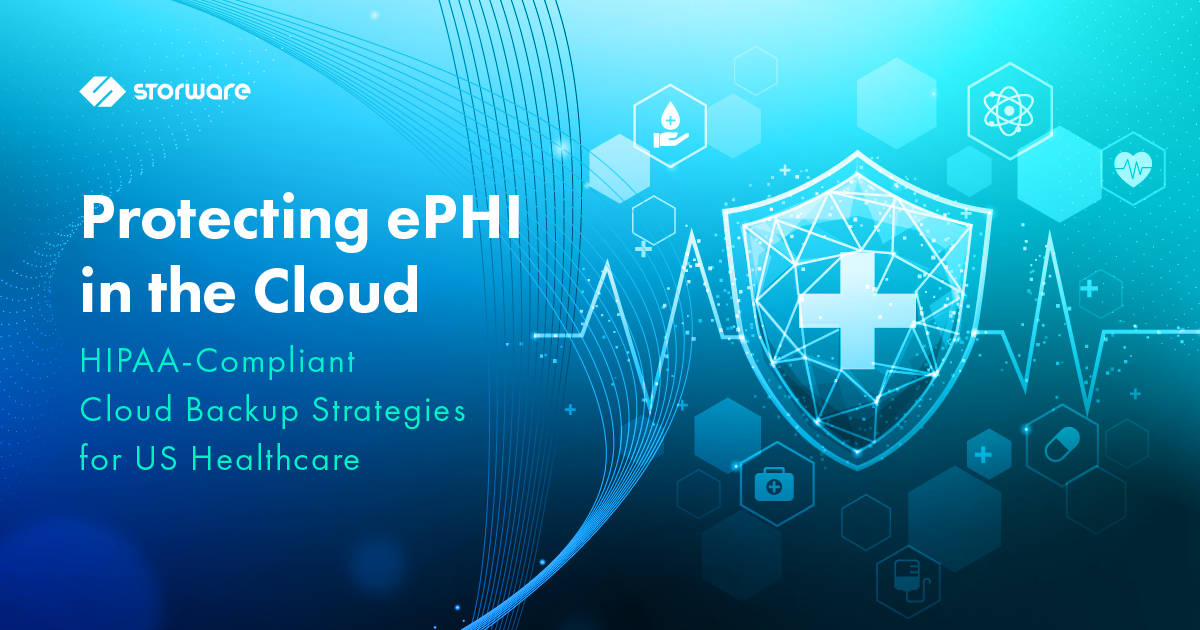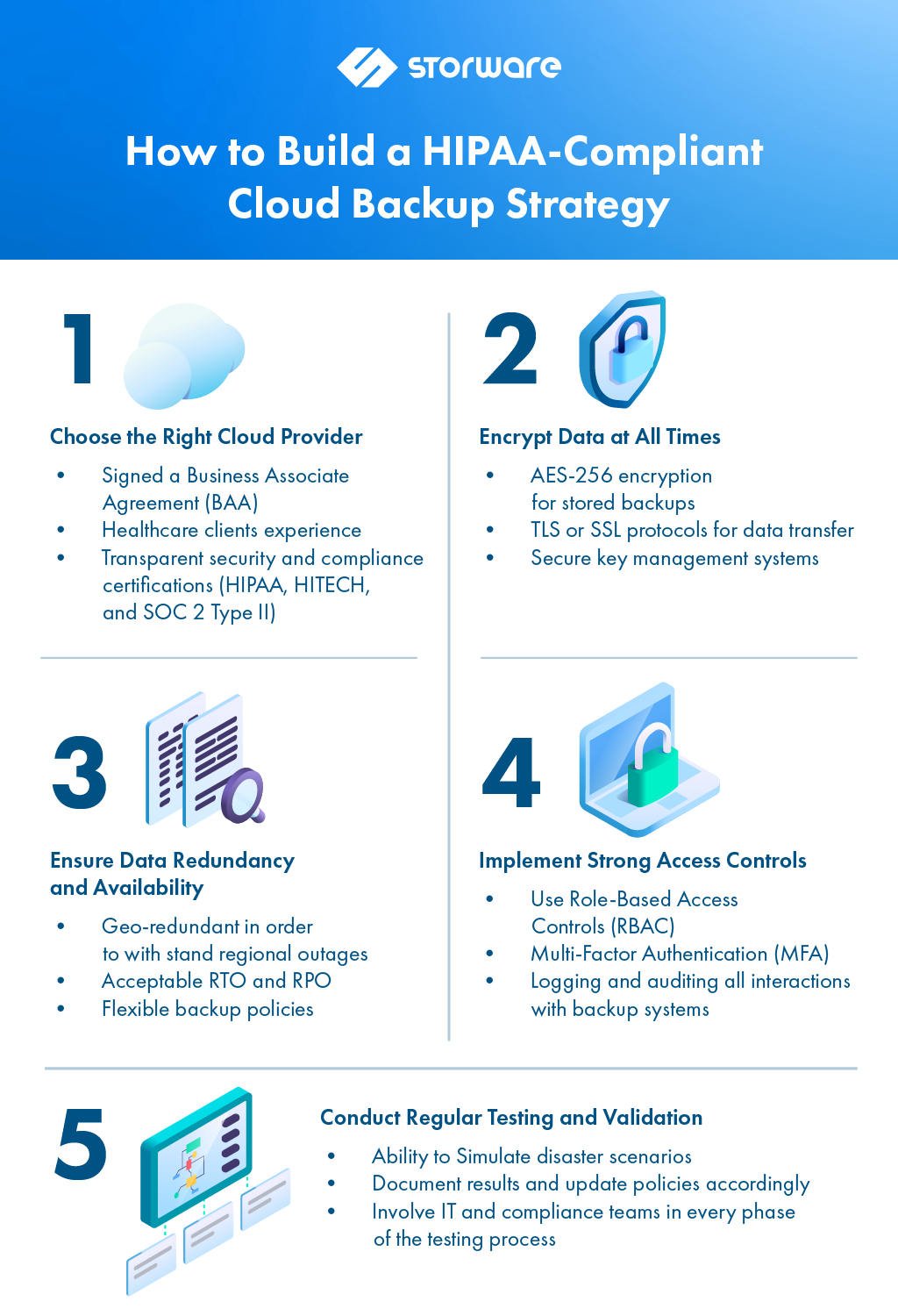Protecting ePHI in the Cloud
Table of contents
Protecting ePHI in the Cloud: HIPAA-Compliant Cloud Backup Strategies for US Healthcare
Managing electronic protected health information (ePHI) in the cloud has become necessary as healthcare organizations progressively choose cloud technologies. This method raises data remote access, cost-effectiveness, and accessibility.

However, it also comes with compliance and security issues. Failing to protect ePHI, even in backups, for covered entities under the Health Insurance Portability and Accountability Act (HIPAA) runs a risk of significant fines, legal action, mistrust development, and damage to patient relationships.
Thus, providers must ensure that their backup plans are safe, tested, and monitored closely against government rules. This post explores the most practical approaches and insights relevant to U.S. healthcare institutions.
HIPAA Requirements for Backing Up ePHI
ePHI protection is governed by the Health Insurance Portability and Accountability Act (HIPAA). This act also specifies how ePHI must be backed up and recovered should a disaster or failure strike. HIPAA outlines critical backup-related criteria but does not specify certain technologies:
- Procedures must be in place for data backup to generate and preserve exact, retrievable copies of ePHI.
- In data recovery plans, organizations must specify how ePHI would be rebuilt following a cybercrime, system outage, or natural disaster.
- Critical systems must be able to operate in emergency conditions to protect data integrity in emergency mode plans.
- Backup and recovery strategies must be routinely tested and changed depending on changing risk.
- Only authorized staff members should access ePHI; audit trails are in place to track interactions.
Meeting these criteria in a traditional on-premise solution is tough enough. In a cloud-based setting, the stakes are even higher, and the strategies more complex.
On-Prem vs. Cloud Backup for HIPAA
| Feature | On-Prem Backup | Cloud Backup |
| Initial Cost | High (hardware, staffing) | Lower (subscription model) |
| Scalability | Limited by physical resources | Virtually unlimited |
| Maintenance | Manual, resource-intensive | Managed by CSP |
| Redundancy | May require a separate off-site site | Built-in multi-region redundancy |
| Disaster Recovery | Requires dedicated DR planning | Often included with DRaaS |
| Physical Security | Controlled by the IT team | Dependent on CSP’s data center practices |
| BAA Requirement | Not applicable | Mandatory with CSP |
| Compliance Flexibility | Complete control, slower changes | Fast updates, shared responsibility |
Cloud backup offers greater flexibility and cost efficiency. However, it shifts part of the security responsibility to your provider. Vetting and partnering with the right cloud service provider (CSP) is critical.
Why Cloud Backup Requires Special Attention
Cloud backup offers agility and cost savings, but it also brings new levels of complexity, especially around shared accountability. Many healthcare businesses wrongly assume their cloud provider manages HIPAA compliance by default. In truth, compliance is a joint effort.
Cloud-specific risks include:
- Multi-tenancy: Data hosted on shared infrastructure increases exposure.
- Remote Access: Greater accessibility can lead to increased attack surfaces.
- Data Sovereignty: The physical location of your data may affect compliance with US regulations.
Understanding your and the provider’s roles is crucial for protecting ePHI.
How to Build a HIPAA-Compliant Cloud Backup Strategy

An effective cloud backup plan has to be proactive, tested several times, and compliant with HIPAA. Here’s how you approach it:
Choose the Right Cloud Provider
Not every cloud vendor is prepared to meet HIPAA’s requirements. You’ll need a provider that:
- Offers a signed Business Associate Agreement (BAA)
- Demonstrates a proven track record with healthcare clients
- Provides transparent security practices and compliance certifications
Seek vendors with industry-standard certifications, including HIPAA, HITECH, and SOC 2 Type II.
Encrypt Data at All Times
HIPAA necessitates the safeguarding of ePHI both at rest and in transit. This means
- Enabling AES-256 encryption for stored backups
- Using TLS or SSL protocols for data transfer
- Implementing secure key management systems
This ensures that the data remains unreadable even if unauthorized actors access backups.
Ensure Data Redundancy and Availability
Cloud backups must be:
- Geo-redundant in order to withstand regional outages.
- Supported by Recovery Point Objectives (RPOs) and Acceptable Recovery Time Objectives (SLAs) specifications.
- Capability of automatic and frequent backups with choices for long-term storage.
Redundancy isn’t just a performance booster; it’s a compliance measure.
Implement Strong Access Controls
Unauthorized access is one of the most common causes of HIPAA breaches. Limit exposure by:
- Using Role-Based Access Controls (RBAC) to grant access based on job roles
- Enforcing the principle of least privilege
- Deploying Multi-Factor Authentication (MFA) for cloud portal access
- Logging and auditing all interactions with backup systems
This creates a controlled, traceable environment around your sensitive cloud data.
Conduct Regular Testing and Validation
A backup that doesn’t work is a liability. HIPAA requires regular testing and revision of all backup and disaster recovery procedures. Best practices include:
- Simulating disaster scenarios to test recovery speed and integrity
- Documenting results and updating policies accordingly
- Involving IT and compliance teams in every phase of the testing process
Testing ensures that your cloud-based recovery plan isn’t just theoretical—it’s reliable when needed.
Common Pitfalls to Avoid
Even well-intentioned organizations can fall into traps that undermine their HIPAA backup strategy. Watch out for these frequent mistakes:
- Assuming all cloud storage is HIPAA-compliant. A vendor’s offering of encryption or redundancy does not automatically satisfy all compliance criteria.
- Failing to sign a business associate agreement (BAA) means your cloud provider is not legally obligated to follow HIPAA.
- Using consumer-grade backup tools. For instance, the Standard edition of Dropbox or Google Drive lacks the restrictions required for healthcare data and isn’t built for HIPAA compliance.
- Ignoring backup monitoring calls for regular validation of completion, integrity, and accessibility.
Steering clear of these traps calls for diligence, teamwork, and vendor responsibility.
The Role of Immutable Backups and Air-Gapping
Healthcare organizations should consider including immutable backups (copies of data that cannot be changed or deleted for a designated period) for extra security. These backups can stop ransomware attackers from either encrypting or destroying recovery information.
In tandem, air-gapping techniques (storing backups in physically or logically separated environments) offer another layer of protection. Appropriately utilized techniques enable you to keep HIPAA compliance even in worst-case situations.
To Sum Up: Compliance is a Continuous Process
Adoption of cloud backup systems only modifies your HIPAA responsibilities rather than absolving them. Protecting ePHI in the cloud calls for a well-crafted backup plan that strikes a compromise between security, performance, and compliance.
To recap, a HIPAA-compliant cloud backup strategy should:
- Built with a vetted provider that offers a BAA
- Include encryption, access controls, and redundancy.
- Be tested and monitored regularly.
- Align with HIPAA’s administrative, physical, and technical safeguards
Cloud backup compliance reflects your company’s dedication to data protection, patient safety, and regulatory responsibility, more than just a checkbox. Your patients and operations will be less vulnerable in the face of growing risks, the more solid your plan is.
